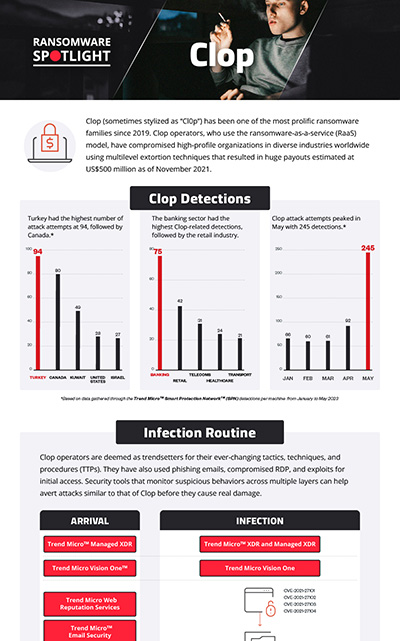Ransom.Win32.CLOP.NV
Trojan:Win32/BunituCrypt.GKM!MTB (MICROSOFT); W32/Qbot.CV!tr (FORTINET)
Windows


Threat Type: Ransomware
Destructiveness: No
Encrypted: Yes
In the wild: Yes
OVERVIEW
This Ransomware arrives on a system as a file dropped by other malware or as a file downloaded unknowingly by users when visiting malicious sites.
It drops files as ransom note. It avoids encrypting files with the following file extensions.
TECHNICAL DETAILS
Arrival Details
This Ransomware arrives on a system as a file dropped by other malware or as a file downloaded unknowingly by users when visiting malicious sites.
Installation
This Ransomware drops the following files:
- {Original Filename w/ Extension}.CIIp → Contains Encrypted Encryption Key.
It adds the following processes:
- {Malware Full Path} runrun
It adds the following mutexes to ensure that only one of its copies runs at any one time:
- ProgramPro#666#666#667
Other Details
This Ransomware does the following:
- It will only proceed to its malicious routine if it is ran as a service.
- It encrypts FIXED and REMOVABLE drives.
- It will attempt to encrypt found Remote Shared Folders.
- It encrypts files depending on their filesize:
- For files with a size that is less than or equal to 17 kilobytes (0x4268 bytes), it will skip encrypting these files.
- For files with a size that is greater than 17 kilobytes (0x4268 bytes) but less than 2.13 MB (0x2089D0 bytes), it would encrypt the file from the 0x4000 position to the end of file.
- For files with a size that is greater than 2.13 MB (0x2089D0 bytes), it would encrypt the file from the 0x10000 position to the 0x2089D0 position.
- Its keystore file ({Original Filename w/ Extension}.CIIp) contains the following:
- Cllp^_-{Encrypted Encryption Key}
It accepts the following parameters:
- runrun → Encrypt only Remote Shared Folders
- temp.ocx → Read the contents of temp.ocx and Encrypt only filepaths listed inside.
Ransomware Routine
This Ransomware avoids encrypting files with the following strings in their file name:
- README_README.txt
- AUTOEXEC.BAT
- AUTORUN.INF
- BOOT.INI
- BOOTMGR.BAT
- BOOTSECT.BAK
- DESKTOP.INI
- ICONCACHE.DB
- NTDETECT.COM
- NTUSER.DAT
- NTUSER.DAT.LOG
- NTUSER.INI
- THUMBS.DB
It avoids encrypting files with the following strings in their file path:
- \Desktop
- \DESKTOP
- $RECYCLE.BIN
- AHNLAB
- ALL USERS
- APPDATA
- BOOT
- BOOTMGR
- CHROME
- DEFAULT
- LOCAL SETTINGS
- MICROSOFT
- MOZILLA
- NTLDR
- PERFLOGS
- PROGRAM FILES
- PROGRAM FILES (X86)
- RECOVERY
- SOPHOS
- SYSTEM VOLUME INFORMATION
- TOR BROWSER
- WINDOWS
- WINNT
It drops the following file(s) as ransom note:
- {Encrypted Directory}\README_README.txt

It avoids encrypting files with the following file extensions:
- .CIIP
- .bat
- .cmd
- .ttf
- .lng
- .hlf
- .chm
- .msi
- .ini
- .ico
- .LNK
- .SYS
- .EXE
- .DLL
- .OCX
- .CI0P
SOLUTION
Step 1
Trend Micro Predictive Machine Learning detects and blocks malware at the first sign of its existence, before it executes on your system. When enabled, your Trend Micro product detects this malware under the following machine learning name:
- Troj.Win32.TRX.XXPE50FFF041
Step 2
Before doing any scans, Windows 7, Windows 8, Windows 8.1, and Windows 10 users must disable System Restore to allow full scanning of their computers.
Step 3
Note that not all files, folders, and registry keys and entries are installed on your computer during this malware's/spyware's/grayware's execution. This may be due to incomplete installation or other operating system conditions. If you do not find the same files/folders/registry information, please proceed to the next step.
Step 4
Restart in Safe Mode
Step 5
Search and delete these files
- {Encrypted Directory}\README_README.txt
- {Original Filename w/ Extension}.CIIp
Step 6
Restart in normal mode and scan your computer with your Trend Micro product for files detected as Ransom.Win32.CLOP.NV. If the detected files have already been cleaned, deleted, or quarantined by your Trend Micro product, no further step is required. You may opt to simply delete the quarantined files. Please check this Knowledge Base page for more information.
Step 7
Restore encrypted files from backup.
Did this description help? Tell us how we did.



